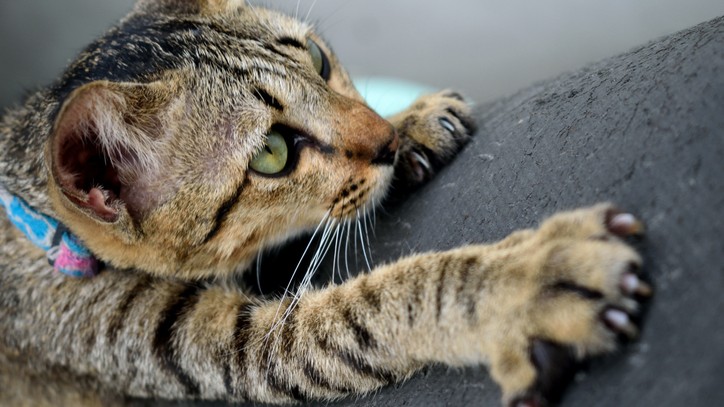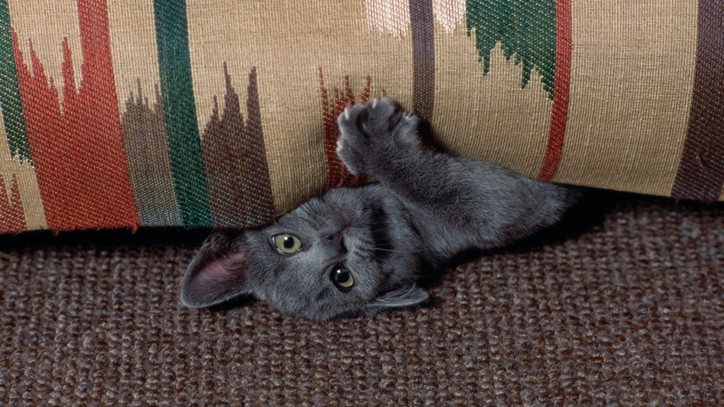How to keep cats from scratching furniture
New sofa? Read our vet’s advice on how to keep cats from scratching the furniture

Scratching is a common behavior in cats, but knowing how to keep cats from scratching the furniture is key to a happy home.
Many pet parents ask the question 'why does my cat scratch the wall?', but furniture scratching is equally common (and problematic!). The good news is that scratching is a very normal behavior and one that you can work with.
Cats scratch for a number of reasons. It’s a way to sharpen and condition their claws and helps to shed the outer layer to keep the claw healthy. It’s also used to communicate between cats – not only do the physical, vertical lines act as a message, but they leave pheromones from their paws behind when they scratch, sending a scent signal to other cats.
Because scratching is normal, it’s important that you don’t prevent your cat from scratching or get cross at them for scratching – they won’t understand why you’re upset. Instead, read on for some tips to stop your cat from scratching the new sofa.
- Best cat toys: Keep your feline friend occupied with these great toys
- Best catnip toys: Amuse your cat with toys they will love
- How to play with a cat: A vet’s advice on keeping your cat active
Why is my cat scratching the furniture?
The first step in stopping your cat from scratching the furniture is to work out why they are doing it. There are a number of possible reasons, and which one it is might depend on whether your cat is new, whether the sofa is new, whether the behavior is new, or whether something else has changed in the house. Some possible reasons why cats scratch the sofa include:
- No suitable alternative, such as the best cat scratching posts
- Not enough scratching posts
- Scratching post is the wrong size or type
- Scratching post is in the wrong place to signal to other cats
- Stress from other cats or household changes
- New sofa causing environmental stress
From reading this list, you might already know which of these is upsetting your cat. If you don’t, talk to your vet or to a feline behaviorist about your set-up to see if they have any ideas.
Getting the scratching post right – what kind of scratching post is best?
The most common reasons why a cat might be scratching your sofa rather than their scratching post is simply that they don’t like the post, it’s not in the right place, or they can’t get to it easily.
When buying a scratching post for your cat, you need one that’s tall enough for your cat to stand and stretch when scratching – about 90cm is the minimum for an average-sized cat, but large breeds may need even taller. It should also be sturdy – a wobbly post will make your cat worried about using it. A cat tree is a favorite option for many cats. Whilst horizontal pads may be preferred by kittens and some adult cats, most cats prefer a post.
The various materials for scratching posts can get confusing. Studies have suggested that rope (sisal) appears to be favored by most cats – but older cats may prefer carpet. If in doubt, get several and see which your pet prefers – this is one of the best ways to reduce inappropriate scratching in the home. You can even try making your own DIY cat scratching posts.
Now think about where it’s placed. Since your cat is leaving a visual and scent signal for other cats, they need the post to be in a strategically useful position, such as near sleeping places, doors, and windows. If it’s hidden away at the top of the house where nobody can see it, it’s likely they will use something that’s more visible. If in doubt, place the post near where they have been scratching already or spread several around.
Lastly, they may need some encouragement to use the post. Don’t pick their paw up and move it to the post – this can cause aversion. Instead, use catnip or special pheromones to encourage your cat to have a go.

Dealing with household stress
On the whole, cats are less likely to scratch inappropriately as they age. However, if they have never been much of a scratcher but have just started, think about whether stress could be a factor. Cats who are stressed by changes in their environment may urinate in unusual places, start spraying, or scratch furniture as a way of re-establishing their territory. Not sure what could be upsetting your cat? Here are some possibilities:
- New pet or family member in the house
- New cat in the neighborhood – even if your cat doesn’t go out they can bully them through the windows
- New furniture or furniture has been moved
- Building work, fireworks, or other unexpected noises
You may be able to remove the source of stress, but you may also have to help your cat learn to manage their anxiety. To help your cat deal with stress, talk to your vet.
They may suggest using a special diet or dietary supplements to help your cat, and may also recommend other changes including hiding places, a ‘safe space’, and feeding regimes. If your vet is stumped, a feline behaviorist may be able to come to the home and make some recommendations.
Stay calm – and reward, reward, reward
It can be frustrating when your cat acts up, but punishment for inappropriate scratching has no effect on the problem. On the other hand, rewarding your cat for using the post correctly has been shown to increase the likelihood of them using it. To learn more, read our feature on how to discipline a cat and encourage good behavior.
How to keep your cat from scratching the furniture – conclusion
To stop your cat from scratching the furniture, you need to think about why your cat is using the sofa or table, and not their post. If they are a recent scratcher, consider whether something else could be upsetting them.
Combining a new post with some stress relief may be all that’s needed to prevent your cat from scratching inappropriately. However, it’s important to remember that scratching is normal, healthy behavior for cats – so don’t get cross with them when they get things wrong!
PetsRadar Newsletter
Get the best advice, tips and top tech for your beloved Pets
After graduating as a vet from the University of Nottingham, Dr Joanna Woodnutt went on to practice companion animal medicine in the Midlands. Since then, she has also written for countless online and print publications and is a regular contributor for Edition Dog Magazine.

